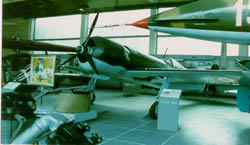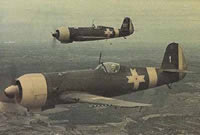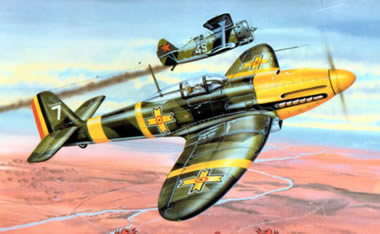


   |
|
|
|
|
|
|
|
|
|
|
|
|
|
|
|
|
|
|
|
The IAR-80 fighter |
|
|
 |
The opportunity was also taken to install self-sealing fuel tanks ( after the first ten planes had been manufactured in December 1942 ) as well as better armor plating behind the pilot. By April 1943, all the 50 airplanes ordered were ready for action.The IAR-80C's were actually supposed to
be delivered as IAR-81 fighter-bombers, but because of increasing demands from squadrons operating on the east
front were completed as fighters instead. |
|||
|
||||
|
|
Technical data of the IAR - 80C
|
Wingspan
|
11 meters
|
|
Length
|
8.97 meters
|
|
Height
|
3.535 meters
|
|
Weight (empty)
|
2200 kg
|
|
Weight (loaded)
|
2880 kg
|
|
Maximum speed at 5000 meters
|
506 km/h
|
|
Climbs to 5000 meters
|
7 minutes
|
|
Maximum operational ceiling
|
10000 meters
|
|
Range
|
730 km or 1330 km ( with external fuel tanks )
|
|
Engine
|
IAR K14 C32 1000A1 rated at 1025 HP
|
|
Armament
|
4 FN 7.92 mm machine guns plus 2 MG/FF-M 20 mm cannons
|
|
Numbers produced
|
50
|
|
Serial numbers
|
241-290
|
The IAR-80M
|
|
Technical data of the IAR - 80M
|
Wingspan
|
11 meters
|
|
Length
|
8.97 meters
|
|
Height
|
3.535 meters
|
|
Weight (empty)
|
2200 kg
|
|
Weight (loaded)
|
2880 kg
|
|
Maximum speed at 5000 meters
|
506 km/h
|
|
Climbs to 5000 meters
|
7 minutes
|
|
Maximum operational ceiling
|
10000 meters
|
|
Range
|
730 km or 1330 km ( with external fuel tanks )
|
|
Engine
|
IAR K14 C32 1000A1 rated at 1025 HP
|
|
Armament
|
4 FN 7.92 mm machine guns plus 2 MG 151/20 mm cannons
|
|
Numbers produced
|
unknown
|
|
Serial numbers
|
unknown
|
|
|
No further trials took place after this experiment and the whole idea was abandoned. The next solution seemed to be BMW 801 engine, that was used for the Focke Wulf FW190 fighter. Its output of 1600+ HP ensured a increase of over 50% in engine power, and its dimensions were roughly the same with those of the IAR K14, although it was significantly heavier. The
Romanian engineers felt confident that they could adapt the BMW 801 for
the IAR-80 and hoped to match or even best the speed of the Messerschmitt Bf-109G. |
 |
|||
|
||||
|
|
|

The IAR-80 : an unknown hero
|